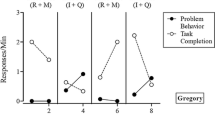Abstract
Following a baseline period, a token reinforcement program was instituted in three resource-room classes for very disruptive children where the children spent 1 hour per day. The only reinforcers used in the token program were those available to any classroom teacher, viz., free time in an activity area. The effects of the token program were evaluated in the three resource-room classes as well as in the homerooms of all students participating in the resource-room program. Following 4 months of the token program, a return to baseline was made in one resource classroom. As assessed by standard classroom observations, the token program was effective in reducing disruptive behavior in all three resource-room classes; and when it was withdrawn in one resource-room class, the disruptive behavior remained at a very low level in the resource room. Ratings by teachers in the homerooms showed a significant reduction in disruptive behavior, but recordings by homeroom observers showed no such reduction. Possible reasons for maintenance of low rates of disruptive behavior after withdrawal of tokens were discussed in terms of the type of reinforcers used.
Similar content being viewed by others
References
Bushell, D., Worbel, P. A., & Michaelis, M. L. Applying “group” contingencies to the classroom study of preschool children.Journal of Applied Behavior Analysis, 1968,1, 55–61.
D'Amato, M. R.Experimental psychology. New York: McGraw-Hill, 1971.
Hopkins, B. L., Schutte, R. C., & Garten, K. The effects of access to a playroom on the rate and quality of printing of first and second grade students.Journal of Applied Behavior Analysis, 1971,4, 71–76.
Kent, R. N., O'Leary, K. D., Diament, C., & Dietz, A. Expectation biases in observational evaluation of therapeutic change, Journal of Clinical and Consulting Psychology, in press, State University of New York at Stony Brook, 1972.
Krasner, L. Behavior therapy.Annual Review of Psychology, 1971,22, 483–532.
Kuypers, D. S., Becker, W. C., & O'Leary, K. D. How to make a token system fail.Exceptional Children, 1968,35, 101–109.
Lepper, M. R., Green, D., & Nisbett, R. E. Undermining children's intrinsic interest with extrinsic rewards: A test of the “overjustification” hypothesis.Journal of Personality and Social Psychology, 1973, in press.
O'Leary, K. D., Becker, W. C., Evans, M. B., & Saudargas, R. A. A token reinforcement program in a public school: A replication and systematic analysis.Journal of Applied Behavior Analysis, 1969,2, 3–13.
O'Leary, K. D., & Drabman, R. Token reinforcement programs in the classroom: A review.Psychological Bulletin, 1971,75, 370–398.
O'Leary, K. D., Kaufman, K. F., Kass, R. E., & Drabman, R. The effects of loud and soft reprimands on the behavior of disruptive students.Exceptional Children, 1970,37, 145–155.
O'Leary, K. D., & O'Leary, S. G.Classroom management: The successful use of behavior modification. New York: Pergamon Press, 1972.
O'Leary, K. D., Poulos, R. W., & Devine, V. T. Tangible reinforcers: Bonuses or bribes.Journal of Clinical and Consulting Psychology, 1972,38(1), 1–8.
Osborne, J. G. Free-time as a reinforcer in the management of classroom behavior.Journal of Applied Behavior Analysis, 1969,2, 113–118.
Salzberg, B. H., Wheeler, A. A., Devar, L. T., & Hopkins, B. L. The effect of intermittent feedback and intermittent contingent access to play or printing of kindergarten children.Journal of Applied Behavior Analysis, 1971,4, 163–172.
Walker, H. M., & Buckely, N. K. Programming generalization and maintenance of treatment effects across time and across settings.Journal of Applied Behavior Analysis, 1972,5, 209–224.
Walker, H. M., Mattson, R. H., & Buckley, N. K.Special class placement as a treatment alternative for deviant behavior in children. (Monograph No. 1, Department of Special Education) Eugene, Oregon: University of Oregon, 1969.
Wasik, B. H. The application of Premack's generalization on reinforcement in the management of classroom behavior.Journal of Experimental Child Psychology, 1970,10, 33–43.
Wolf, M. M., Giles, D. K., & Hall, R. U. Experiments with token reinforcement in a remedial classroom.Behavior Research and Therapy, 1968,6, 51–64.
Author information
Authors and Affiliations
Additional information
This project was performed pursuant to grant OEG-0-71-2872 from the U.S. Office of Education, Department of Health, Education and Welfare. The opinions expressed herein, however, do not necessarily reflect the position or policy of the U.S. Office of Education, and no official endorsement by the U.S. Office of Education should be inferred.
Thanks are due Mrs. S. Ciccione and Miss Diedre Dennehy, teacher and teacher aide of the classes here discussed; Mr. Donald Mirch, elementary principal; and Mr. Ray McGory, Assistant Principal, O'Neill School, Central Islip, New York. The aid of Hillary Turkewitz, Arthur Robin, and Alien Dietz in data analysis and coordination of observers was especially appreciated. Comments of Jeffrey Felixbrod and Susan O'Leary on an earlier version of this manuscript were very helpful.
Rights and permissions
About this article
Cite this article
O'Leary, K.D., Drabman, R.S. & Kass, R.E. Maintenance of appropriate behavior in a token program. J Abnorm Child Psychol 1, 127–138 (1973). https://doi.org/10.1007/BF00916108
Issue Date:
DOI: https://doi.org/10.1007/BF00916108




